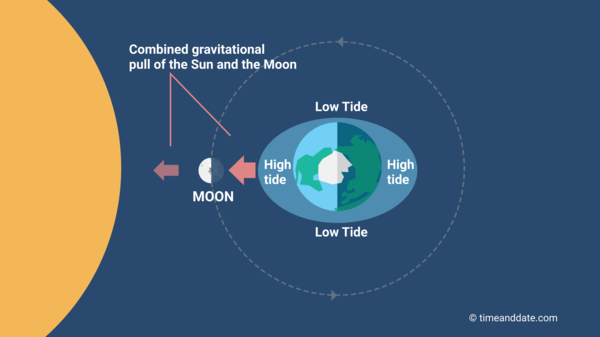It is because of the sun moons gravity that we have high low tides

Why Do We Have High and Low Tides?

Have you ever wondered why our oceans experience high and low tides? The phenomenon of tides is indeed fascinating and can be attributed to the gravitational forces exerted by both the Sun and the Moon. In this article, we will explore how these celestial bodies impact the rise and fall of the ocean’s waters.
The gravitational pull of the Moon plays a significant role in the formation of tides. As the Moon orbits around the Earth, it exerts a gravitational force on the ocean. This force causes the water nearest to the Moon to have a slightly higher gravitational pull than the Earth’s center, creating a bulge of water on the side of the Earth facing the Moon. This bulge is what causes high tides.
On the opposite side of the Earth, away from the Moon, there is another bulge of water. This bulge is due to the centrifugal force caused by the Earth and Moon revolving around their common center of mass. This effect creates a high tide on the opposite side of the Earth, known as the antipodal tide.

Now, you might be wondering why there are two bulges instead of just one. This is where the Sun’s gravitational force comes into play. Although the Sun is much further away from the Earth than the Moon, it still has a substantial gravitational pull on our planet. The Sun’s force acts in conjunction with the Moon’s force, reinforcing the bulges created.
When the Sun, Moon, and Earth align during a new or full moon, their combined gravitational force is at its greatest, resulting in higher high tides and lower low tides, known as spring tides. Conversely, when the Sun and Moon are at right angles to each other during the first and third quarter phases, their gravitational forces partially cancel each other out, resulting in lower high tides and higher low tides, known as neap tides.
In addition to the gravitational forces, other factors such as the size, shape, and depth of the ocean basins also influence the exact height and timing of tides at specific locations. Nonetheless, the primary driving force behind tides on Earth is undeniably the gravitational pull of the Sun and Moon.
The intricate dance between the Sun, Moon, and Earth is responsible for the ebb and flow of our planet’s vast oceans. The tides serve as a reminder of the powerful forces that shape our world. So the next time you find yourself taking a stroll along the beach, take a moment to appreciate the celestial mechanics behind the mesmerizing tides that gently lap against the shore.
Tags
Share
Related Posts
Quick Links
Legal Stuff

